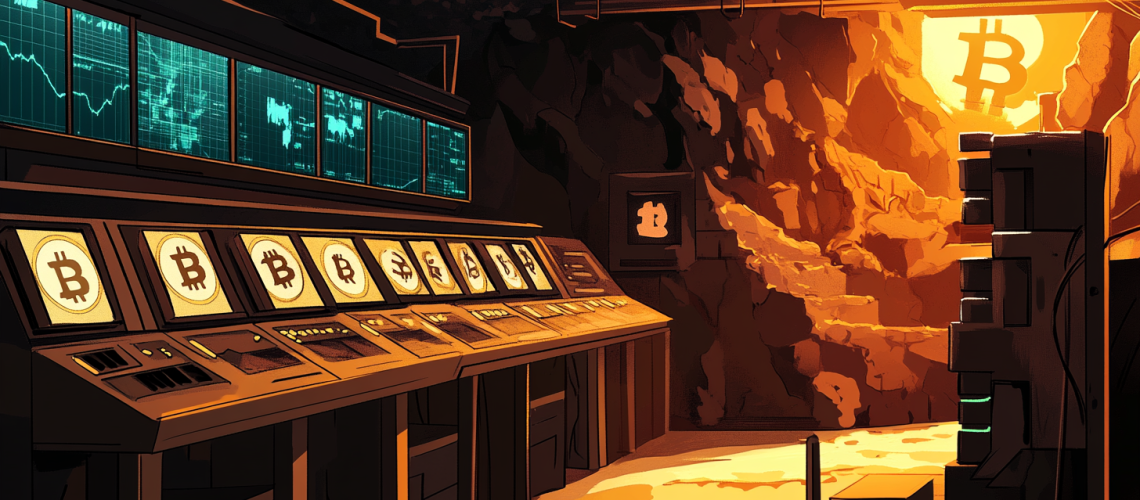Bitcoin miners are witnessing a dramatic reduction in their reserves, which have now fallen to their lowest levels in three years. This development comes in the wake of the latest Bitcoin halving, an event that has historically reshaped the cryptocurrency landscape. As these reserves dwindle, questions arise about what this means for the future of Bitcoin and the broader crypto market.
Understanding the Halving’s Impact
To fully grasp the significance of the current situation, it’s essential to understand the Bitcoin halving and its profound impact on the network. Bitcoin halving occurs roughly every four years, reducing the block reward for miners by 50%. This built-in mechanism aims to slow the issuance of new bitcoins, making the cryptocurrency scarcer over time. While the reduction in supply is intended to create upward pressure on Bitcoin’s price, it also directly impacts miners’ revenue.
For miners, the halving means that they receive half as many bitcoins for the same amount of work. The most recent halving, which took place in May 2024, reduced the block reward from 6.25 bitcoins to 3.125 bitcoins. This event was anticipated by the market, but its real effects are now being felt as miners grapple with the reduced income in the face of rising operational costs, including energy prices and hardware expenses.
The Decline in Reserves: A Closer Look
Miners’ reserves—the amount of Bitcoin held by miners rather than sold into the market—are a critical metric in understanding the state of the mining industry. Historically, miners have built up reserves during periods of lower profitability, selling their holdings when prices rise to maximize revenue. However, the latest data indicates that miners are depleting these reserves at an alarming rate.
This depletion suggests that many miners are under financial pressure, forced to sell their Bitcoin holdings to cover operational costs. The sharp decline in reserves could indicate that miners are struggling to stay afloat in the post-halving environment, leading to a potentially precarious situation for the entire Bitcoin network.
Market Implications: Scarcity and Price Volatility
The drop in miners’ reserves could have significant implications for Bitcoin’s price and market dynamics. As miners hold less Bitcoin, the available supply in the market decreases, potentially leading to scarcity. In a market driven by supply and demand, such scarcity could push Bitcoin’s price upward. This is especially true if demand remains steady or increases, as fewer coins would be available to meet the market’s needs.
However, the relationship between miners’ reserves and Bitcoin’s price is not straightforward. If miners are forced to sell off large amounts of Bitcoin to stay solvent, this could flood the market with supply, driving prices down. The market’s reaction to such sales would depend on the broader sentiment—whether investors view these sales as a buying opportunity or a sign of trouble ahead.
Miner Consolidation and Centralization Risks
As miners face financial strain, there is a growing likelihood of industry consolidation. Smaller and less efficient mining operations may be unable to sustain themselves, leading to mergers or acquisitions by larger players. This consolidation could lead to increased centralization within the Bitcoin mining industry, where a few large entities control a significant portion of the network’s hash rate.
Centralization poses risks to Bitcoin’s decentralization ethos, one of its core principles. A more centralized mining network could make the Bitcoin blockchain more vulnerable to manipulation or censorship, undermining the trust that users place in the system. This centralization concern has been a topic of debate within the Bitcoin community, with the potential for it to influence future network developments and policies.
The Role of Energy Costs and Environmental Concerns
One of the critical challenges facing Bitcoin miners, especially in the aftermath of the halving, is the rising cost of energy. Bitcoin mining is an energy-intensive process, and fluctuations in energy prices can significantly impact miners’ profitability. In regions where electricity costs are high, miners may find it increasingly difficult to maintain their operations, further contributing to the depletion of reserves.
Moreover, the environmental impact of Bitcoin mining has become a growing concern, attracting scrutiny from regulators and environmental groups. As miners seek to cut costs, some are turning to renewable energy sources, which, while beneficial in the long term, require significant upfront investment. This transition could add to the financial strain on miners in the short term, exacerbating the challenges they face in the post-halving landscape.
Regulatory Uncertainty and Its Potential Effects
The regulatory environment surrounding Bitcoin and cryptocurrencies is another critical factor that could influence the mining industry and the broader market. Governments and regulatory bodies around the world are increasingly focusing on cryptocurrency regulations, with some proposing stricter oversight of mining operations due to environmental concerns and the potential for illicit activity.
In some regions, miners are facing increased scrutiny, with potential regulations that could limit or tax mining activities. For example, countries with large mining operations, such as China (before the 2021 crackdown) and the United States, are considering regulations that could impact the cost and feasibility of mining. If such regulations are implemented, they could further strain miners’ finances, potentially accelerating the depletion of reserves and contributing to market volatility.
Long-Term Outlook: Challenges and Opportunities
While the current situation presents significant challenges, it also offers opportunities for innovation and adaptation within the Bitcoin ecosystem. Miners may explore new strategies to enhance efficiency, such as adopting more energy-efficient mining hardware, leveraging renewable energy sources, or optimizing operations through economies of scale.
Additionally, the reduced supply of Bitcoin due to declining reserves could lead to increased interest from institutional investors, who may view Bitcoin’s scarcity as a positive factor. If institutional demand grows, it could offset some of the downward pressure caused by miners selling their holdings, stabilizing the market and potentially driving prices higher in the long run.
Conclusion: Navigating Uncharted Waters
The depletion of Bitcoin miners’ reserves marks a significant moment in the cryptocurrency’s history, highlighting the challenges that come with each halving event. As miners navigate this new landscape, their decisions will likely have far-reaching implications for Bitcoin’s price, market dynamics, and the broader crypto ecosystem.
For investors, understanding these developments is crucial for making informed decisions in an increasingly complex and volatile market. While the future remains uncertain, one thing is clear: the actions of Bitcoin miners will continue to play a pivotal role in shaping the trajectory of the cryptocurrency market in the years to come.
As the industry evolves, stakeholders across the spectrum—from miners to regulators, investors to developers—will need to adapt to the changing dynamics to ensure the continued growth and success of Bitcoin and the wider digital currency landscape.


